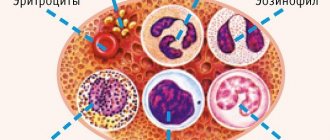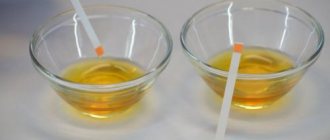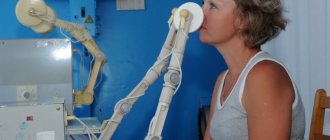Urine is a unique biological material, the study of which makes it possible to diagnose diseases not only of the urinary system, but also of other organs if they are affected by a pathological process - diabetes, gout, rheumatoid arthritis. Under normal conditions, red blood cells and protein should not be detected in the urine; the presence of 2–4 leukocytes in the field of view is allowed. In the case of increased levels of white blood cells in the urine, we are talking about leukocyturia, which is evidence of an inflammatory process. For a more accurate diagnosis, a number of additional tests are prescribed to determine the nature of leukocyturia and identify the source of its appearance.
The essence of the study
When conducting a general analysis of urine, the detection of an increased content of leukocytes in it allows one to suspect the presence of an inflammatory process in the kidneys, ureters, bladder, urethra, and in men also in the prostate gland. A three-glass urine sample is designed to help localize the focus of the pathological process and establish the location of the lesion. The three-glass test is an additional research method after a general urine test has been performed and according to Nechiporenko, it is never prescribed independently. The essence of the method is to sequentially collect urine into three special containers for collecting urine during one act of urination. In this case, it is not allowed to collect urine in one container and then pour the contents of the container into three jars; it is not allowed to pour urine from one jar to another. It is also important to maintain the proportions of the collection.
A three-glass urine sample is not an independent test; it is indicated after detection of an increased content of leukocytes and erythrocytes in a general urinalysis
A three-glass test helps to establish the localization of the lesion - so, if leukocytes and red blood cells are detected only in the initial portion, we are most likely talking about a pathological process in the urethra, in the last container - the bladder. If hematuria (the presence of red blood cells in the urine) and leukocyturia are observed in all three samples, the kidneys are most likely affected. The advantages of this method include simplicity, accessibility and low cost. However, there are a number of disadvantages - low information content, high probability of violation of urine collection technique, and mixing up containers. At the present stage, most information about the localization of the lesion process can be obtained by ultrasound, cystoscopy, urography, computed tomography, but we should not forget about the rather high cost of these studies and the difficulty of carrying out some manipulations (for example, cystoscopy) in children.
Indications and contraindications for the study
A three-glass urine sample is prescribed to establish the possible localization of the process when an increased content of erythrocytes and leukocytes in the urine is detected under the following conditions:
- frequent painful urination both during the day and at night;
- the appearance of purulent discharge from the urethra;
- suspected malignant and benign neoplasms of the urinary system, polyps;
- to confirm the diagnosis of prostate adenoma, chronic prostatitis;
- suspected glomerulonephritis and pyelonephritis;
- presence of pain in the lumbar region and lower abdomen;
- the presence of other pathological impurities in the urine (pus, bacteriuria, a large number of epithelial cells).
Article on the topic: Nutrition before intestinal colonoscopy
A contraindication for prescribing this test is the presence of menstruation or other bleeding in women.
The purpose of this test is not indicated if a general urine test does not reveal any changes. You should not take a test if the day before there was sexual contact, alcohol consumption, or the use of certain medications - rifampicin, metronidazole, salicylates. A contraindication to the use of this test is also a cystoscopy performed the day before.
The essence of a two-glass urine sample
A general urine test shows the condition of the urinary system, but to determine the specific affected organ, the glass method is used. The organs of the genitourinary system are conventionally divided into two floors: upper and lower. The upper one consists of the kidneys and ureters, the second one consists of the bladder and urethra. Urine accumulates both here and there, so a general analysis will tell about problems with the urinary system as a whole, and a 2-glass urine sample gives information from which of the two floors the results deviating from the norm come from.
When should I take it?
To be referred for testing, the following diseases become suspected:
- pyelonephritis;
- kidney tuberculosis;
- glomerulonephritis;
- tumors of the urinary system;
- cystitis;
- injuries;
- urethritis;
- prostatitis.
Preparation for the study and urine collection technique
First of all, for the analysis you will need three sterile containers designed for collecting urine. If such a container has already been used to collect biological material, it cannot be reused. Each container must be signed and numbered to avoid confusion.
To carry out a three-glass sample, you must use a sterile container designed for urine collection.
Although preparing for a three-glass test is simple, it still requires compliance with a number of rules. Ideally, it is recommended to collect morning urine, as it is the most concentrated, but if this is not possible, urine obtained at any other time of the day can be used for analysis. It is important not to urinate for 4–5 hours before the test. Before the analysis, it is recommended not to eat foods that can change the color of urine - for example, beets, as well as a number of medications (the same rifampicin can change the color of urine). It is not recommended to use diuretics and foods that have a diuretic effect - watermelons, melons, grapes, as they can affect the density of urine. The day before the analysis, sexual contact, heavy physical activity, drinking coffee and alcoholic beverages, and smoking are contraindicated.
Preparation
A two-glass test is an additional method of examining a patient if the doctor has previously suspected any pathology or abnormality in the functioning of the urinary system. To confirm the primary diagnosis, it is recommended to submit biological material according to the proposed scheme.
During preparation for analysis, you should avoid taking foods with a high content of pigments. Source: bestsurprise.ru
In order for the results to be correct in the future, you must adhere to the following recommendations:
- Two days before urine collection, you should exclude from your diet the consumption of foods with a high level of pigmentation (red beets, blueberries, carrots, asparagus), since they can change the color of the material;
- It is strictly forbidden to consume alcoholic beverages of varying degrees of strength;
- Eating hot, spicy and salty foods is prohibited;
- It is unacceptable to take diuretics on the eve of the study;
- You should abstain from intimate contact for at least 3 days.
Doctors also draw attention to the fact that representatives of the fairer sex need to reschedule the collection of biological material if they have menstrual bleeding. If you neglect this rule, then unnecessary vaginal discharge will end up in your urine. A few days before the test, you need to minimize physical activity and eliminate stress.
Methodology
Immediately before collecting urine, it is necessary to thoroughly clean the external genitalia, washing them without using soap or disinfectants. When collecting urine, it is recommended for a man to pull back his foreskin, and for a woman to cover the entrance to the vagina with a tampon. Urine is collected sequentially into three containers, with approximately one-fifth of it going into the first, three-fifths into the second, and one-fifth into the third. Collecting urine for analysis in all three containers must be done in one act of urination, and transfusion of urine from one container to another is not allowed . The process of collecting urine to conduct a three-glass sample in men with suspected prostate pathology has certain features. In this case, the first two portions of urine are collected using the method described above, then the act of urination is interrupted, and the subject is given a prostate massage. At the same time, its secretion enters the bladder; after the prostate massage, the man must collect a third portion of urine.
Article on the topic: Duplex transcranial ultrasound scanning or examination of the vessels of the head and neck: interpretation
Collected urine cannot be stored or frozen, and must be delivered to the laboratory for analysis within two hours.
Video: method of conducting a three-glass urine sample in women
Decoding the results
The main parameters that are assessed when deciphering the results of a three-glass sample are the number of leukocytes (analysis of the degree of leukocyturia) and erythrocytes (analysis of the degree of hematuria) in all three portions. The color of urine, its density, the presence of epithelial cells and bacteria are also assessed. Normally, these indicators should look like this:
- red blood cells - no more than 3 per field of view;
- leukocytes - in men no more than 3, in women no more than 5 in the field of view;
- epithelial cells - 2–4 per field of view;
- urine density - 1008–1024;
- color - yellow, straw yellow;
- Bacteria should normally be absent.
When assessing the content of white and red blood cells, a distinction is made between leukocyturia or initial hematuria - the largest number of cells in the first portion of urine, terminal - in the third portion, and total - in all three portions of urine a change in its composition is noted. The appearance of hematuria or leukocyturia in all three portions with a high degree of probability indicates the localization of the pathological process in the kidneys. Possible results when interpreting the analysis are shown in the table below.
Table: interpretation of the results of a three-glass urine sample
| Portion of urine | Type of hematuria | For what lesions is it possible? | Type of leukocyturia | Possible pathological processes |
| First | Initial |
| Initial | The process is localized in the urethra - urethritis of bacterial and viral etiology |
| Last | Terminal | The pathological process is localized in the bladder or prostate:
| Terminal | Pathology of the bladder, its neck or prostate:
|
| All three | Total | The process is localized in the kidneys or ureters:
| Total | Inflammatory process in the kidneys, ureters, bladder:
|
It should be noted that conducting a three-glass urine sample is more indicated for men, since the third portion of urine serves to assess the condition of the prostate gland. In women, due to the shorter and wider urethra, a two-glass test is more often prescribed, the algorithm for which is similar, but the urine is collected in only two containers. The detected pathology in the first glass indicates damage to the urethra, in the second - to the bladder. If hematuria and leukocyturia are detected in both portions of urine, this fact with a high degree of probability indicates the localization of the pathological process in the kidneys.
A three-glass urine sample is a simple and accessible method that allows you to clarify the localization of damage to the urinary organs if an increased content of leukocytes and erythrocytes is detected in a general urine test. It is not an independent research method; failure to comply with the urine sampling methodology can lead to incorrect interpretation of the analysis. At the present stage, due to the technical capabilities of high-precision ultrasound diagnostics, cystoscopy and computed tomography, they are used quite rarely.
General characteristics of the three-glass sample method
Urine examination by performing a three-glass sample is a special analysis that helps identify the location of inflammation. The pathological process can affect:
- kidneys;
- bladder;
- urethra;
- prostate.
This method is often prescribed when recognizing diseases in the urinary system and makes it possible to clarify the results of previously performed urine tests: general or Nechiporenko.
Urine analysis using the three-glass test method is carried out only after receiving unsatisfactory results of a general urine test
In addition to determining the location of inflammation, a three-glass test helps in the differential diagnosis of diseases of the urinary system with extrarenal pathologies, as well as in accurately making a diagnosis and prescribing medications. The undoubted advantages of this analysis are accessibility, simplicity and low cost.
A significant disadvantage of the study is the low information content in case of violation of the rules for urine collection. Often, patients do not follow the recommended rules for collecting biomaterial, confuse the containers and terms of transportation of samples taken for diagnosis - all this leads to receiving false information about the health of the person being examined.
Today, urine analysis using the three-glass test method is somewhat outdated, as other diagnostic procedures are becoming available to the patient, more accurate and efficient: computed tomography of the kidneys and bladder, ultrasound, urography and cystoscopy. However, obtaining a conclusion about the functioning of the urinary system using such diagnostics is limited by the high cost of studies, which can also be painful (for example, cystoscopy).
With a urine test, things are not so simple. Even if you collect urine in different jars at the same time, the results may be different. There is even such a study as a “three-glass urine sample.” The level of inflammation is approximately determined. Similarly, a blood test may differ due to drinking regimen, nutrition, sampling method, etc. Of course, the analysis should not vary significantly, but the scope can be decent. Therefore, one should not immediately blame laboratory assistants for dishonesty. In any case, tests are auxiliary diagnostic methods, and not a final diagnosis.
Miranda
https://detkino.ru/gorod/-surgut-/phpbb/viewtopic.php?f=26&t=21151&view=next
As a rule, diagnosing diseases using the three-glass test is recommended only for men, since sampling the last portion of urine is necessary to study the functioning of the prostate gland. Women, due to their physiological characteristics (small and wide urethra), undergo urine testing using a two-glass sample to obtain true test results. In this case, a discrepancy with the norm in the first sample will signal the course of inflammation in the urethra, in the second - in the bladder, and in both at once - the presence of kidney pathology.
The essence of analysis
With a three-glass sample, three portions of urine are examined, which the patient needs to collect during a single urination. It is necessary to submit only primary morning urine for analysis, observing the following ratios of the volume of excreted urine:
- a fifth of the total volume of urine excreted should be collected in the first tube (a disposable sterile container is used to collect biological fluids);
- in the second - three parts out of five;
- in the third - the last fifth part.
It is strictly forbidden to collect the entire portion of urine in one container and then pour it into test tubes - this will give unreliable results.
The analysis itself is based on the principle that a person’s urine should normally contain a small number of leukocytes - special blood cells that react to harmful bacteria entering the body. If the microbes do penetrate the kidneys or another place in the urinary system, then the immune system responds with a sharp increase in the number of white blood cells in the affected area to protect the healthy organ. If there are a lot of bacteria, this leads to the death of leukocytes, which are found in the urine.
A three-glass test makes it possible to determine the location of the inflammatory process caused by an attack of bacterial cells. If during the test deviations are detected in the first tube, this indicates pathology in the urethra, in the second it signals the development of inflammation in the bladder, in the third it indicates damage to the prostate gland.
The study of selected samples allows us to determine the localization of the pathological process that caused the appearance of red and white blood cells in the patient’s urine
Indications and limitations for diagnostics
The doctor prescribes a urine test for the patient using a three-glass sample in the presence of the following indications:
- bacterial prostatitis in acute or chronic stages;
- non-bacterial prostatitis in a sluggish form;
- development of prostate adenoma;
- the urge to urinate frequently, which is accompanied by pain and burning;
- the presence of nagging, recurrent pain in the lower back or lower abdomen;
- assumption of growth of tumors or polyps in the urinary organs;
- suspicion of kidney inflammation and glomerulonephritis;
- increased frequency of urination at night or during the day;
- the appearance of discharge from the urethra with blood or pus, both before or after urination, and during it;
- identification of bacteria, red blood cells, white blood cells, or an abnormal number of epithelial cells in a previously completed general urine test.
It is contraindicated to donate urine for testing during bleeding from the genitals and menstruation in women. Also, the analysis is not performed if the patient had a cystoscopy the day before. The indicators will ultimately turn out to be unreliable if the day before the urine test the subject had sexual intercourse, and also if the patient took medications that affect the color of urine and its composition.











